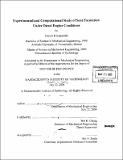| dc.contributor.advisor | Wai. K. Cheng. | en_US |
| dc.contributor.author | Kitsopanidis, Ioannis, 1975- | en_US |
| dc.contributor.other | Massachusetts Institute of Technology. Dept. of Mechanical Engineering. | en_US |
| dc.date.accessioned | 2006-03-24T18:40:52Z | |
| dc.date.available | 2006-03-24T18:40:52Z | |
| dc.date.issued | 2004 | en_US |
| dc.identifier.uri | http://hdl.handle.net/1721.1/30330 | |
| dc.description | Thesis (Ph. D.)--Massachusetts Institute of Technology, Dept. of Mechanical Engineering, 2004. | en_US |
| dc.description | Includes bibliographical references (p. 225-230). | en_US |
| dc.description.abstract | Past research has shown that during diesel combustion, soot is formed in local premixed fuel-rich regions. This project focuses on the fundamentals soot formation under fuel-rich conditions similar to those in diesel engine operation. Since these conditions cannot be easily reproduced in typical laboratory scale experiments, such as flat-flame burners, and since diesel engine data are difficult to interpret because of uncertainty in the local charge composition and thermal state, a new rapid compression machine (RCM) was built to study the phenomenon. The RCM provides a well-controlled and uniform engine-like thermal environment, where mixing and chemistry are decoupled. Fuel-rich mixtures of n-butane and air were primarily used in this study; aromatics, oxygenates and cetane improvers completed the test matrix. Line-of-sight absorption technique was used to investigate the details of soot evolution. The primary data set consisted of soot volume loading history for selected fuels at various equivalence ratios, temperatures and pressures. Based on existing sub-models, a detailed chemical kinetic calculation leading to soot particles was per- formed to study the relative importance of the underlying chemistry. The results show that the initial soot volume grows exponentially with time, reflecting an "autocatalytic" mechanism. The growth rate depends strongly on temperature and pressure. The lower rates observed for richer mixtures can be attributed to lower temperatures after the end of the main heat release process, when most of the soot is formed. Soot yield increases steadily with fuel-air equivalence ratio and depends on fuel structure. Toluene addition to n-butane increases the final soot yield at constant fuel-air equivalence ratio (-1%/1% toluene by mol) but not at constant C/O ratio. | en_US |
| dc.description.abstract | (cont.) Oxygenates totally suppress soot formation at or above 30% oxygen in fuel by mass. Since soot formation is kinetically limited at lower temperatures and soot precursors are not thermodynamically stable at higher temperatures, soot yield exhibits a bell-shape dependence on temperature with a maximum at approximately 1800-2000K. Thus different surface growth mechanisms prevail across the temperature range; the relative contribution of C2H2 over PAH to soot growth increases with temperature. Even though nucleation is mostly governed by PAH coalescence, it was found that the C2H2 route is not negligible under certain conditions. The kinetics of fuel-rich combustion was found to be sensitive to the fuel+HOO reaction. Suggestions are made for better correlation between model and experiments regarding ignition delay and rate of heat release. While performing this study, insight was gained into RCM operation. Assuming uniform and homogeneous environment at the end of compression, was sufficient to model ignition delays under most conditions (2-10 ms), but not rate of heat release and maximum pressure. CFD analysis predicted non-negligible temperature stratification at the end of compression (-80% of mass within 50K). A multizone model, taking into account zones of constant mass and allowing heat transfer and flow into the crevice, was developed and improved the agreement significantly. | en_US |
| dc.description.statementofresponsibility | by Ioannis Kitsopanidis. | en_US |
| dc.format.extent | 230 p. | en_US |
| dc.format.extent | 11079129 bytes | |
| dc.format.extent | 11109308 bytes | |
| dc.format.mimetype | application/pdf | |
| dc.format.mimetype | application/pdf | |
| dc.language.iso | eng | en_US |
| dc.publisher | Massachusetts Institute of Technology | en_US |
| dc.rights | M.I.T. theses are protected by copyright. They may be viewed from this source for any purpose, but reproduction or distribution in any format is prohibited without written permission. See provided URL for inquiries about permission. | en_US |
| dc.rights.uri | http://dspace.mit.edu/handle/1721.1/7582 | |
| dc.subject | Mechanical Engineering. | en_US |
| dc.title | Experimental and computational study of soot formation under diesel engine conditions | en_US |
| dc.type | Thesis | en_US |
| dc.description.degree | Ph.D. | en_US |
| dc.contributor.department | Massachusetts Institute of Technology. Department of Mechanical Engineering | |
| dc.identifier.oclc | 61125427 | en_US |
